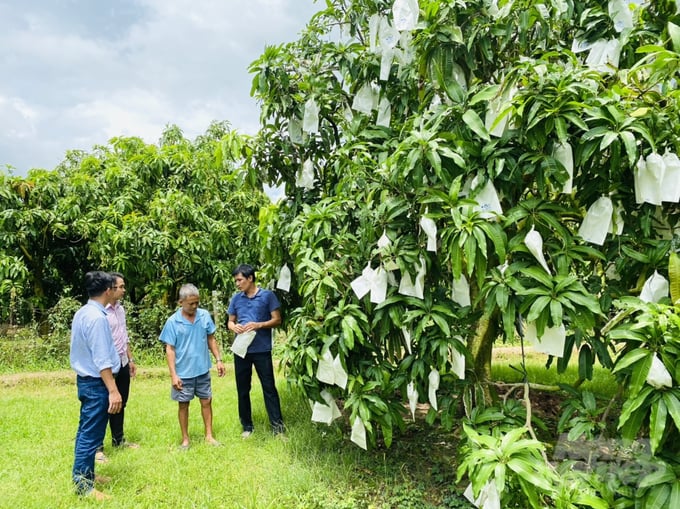May 24, 2025 | 01:18 GMT +7
May 24, 2025 | 01:18 GMT +7
Hotline: 0913.378.918
May 24, 2025 | 01:18 GMT +7
Hotline: 0913.378.918

The agriculture sector in An Giang focuses on using cooperatives and cooperative groups as the core in organizing production and linking within the value chain. Photo: Le Hoang Vu.
The fruit industry in An Giang is showcasing remarkable potential in fulfilling both the quantity and quality requirements for domestic and international markets. The active involvement of cooperatives, cooperative groups and enterprises is fostering a sustainable ecosystem for both the production and consumption of agricultural products, thereby enhancing the value of local crops.
With approximately 20.000 hectares of land dedicated to fruit cultivation and a total production output of over 350.000 tons in 2023, An Giang has become one of the leading fruit production hubs in the Mekong Delta region. Major fruit products include 225.000 tons of mangoes, 14.000 tons of bananas, 3.600 tons of durian, 2.500 tons of longan and 22.500 tons of jackfruit. Notably, the province has been granted 514 registered planting area codes for both the domestic and export markets, creating favorable conditions for penetrating demanding markets such as the United States, the European Union, Japan and South Korea.
Ms. Nguyen Thi Minh Thuy, Vice Chairwoman of the An Giang Provincial People's Committee, emphasized the critical role that cooperatives and cooperative groups play in organizing production and linking farmers within the value chain. By fostering collaborations between farmers and cooperatives to establish large-scale production groups, this approach strengthens the ability to produce and distribute fruit efficiently while mitigating risks in the fruit consumption process at local levels.
Looking ahead to 2030, An Giang aims to have 50% of its fruit-growing areas certified with planting area codes and meeting production standards such as VietGAP and GlobalGAP. This certification will improve the competitiveness and export value of the province's agricultural products.
A prime example of the success of production and export linkages is the GAP Cu Lao Gieng Cooperative in Cho Moi district. Mr. Nguyen Minh Hien, the Director of the Cooperative, shared that it currently has more than 100 official members and a total of 243 hectares of linked production area, generating over 1.700 tons of mangoes each year. These efforts have led the cooperative to secure export contracts for fresh mangoes with several major companies, including Hoang Phat Fruit Co., Ltd., Chanh Thu Co., Ltd. and T&T Group.

An Giang has set a target to have 50% of its fruit-growing areas granted planting area codes by 2030. Photo: Le Hoang Vu.
In addition, the cooperation with foreign companies such as The Fruit Republic Co., Ltd. in Can Tho has opened up greater opportunities for An Giang's fruit industry. According to Mr. Privet Nicolas Marcel René, CEO of The Fruit Republic, the company is currently developing over 50 hectares of seedless melons that meet GlobalGAP standards. They also plan to expand this area to 200 hectares between 2025 and 2027 to meet the growing demand for exports.
To respond to the increasing demand from international markets, An Giang has been focusing on implementing policies to support sustainable production, with particular emphasis on staggering harvest seasons to avoid market oversupply, a common issue known as "market glut".
Mr. Nguyen Si Lam, Director of the An Giang Department of Agriculture and Rural Development, shared that in addition to increasing the area of mangoes that meet GlobalGAP standards, the province is also prioritizing the application of advanced technologies in preserving and processing other agricultural products.
In parallel, An Giang's agriculture sector continues to create favorable conditions for businesses, encouraging them to invest in building modern processing plants and advanced storage facilities. This not only adds value to agricultural products but also ensures a steady and stable consumption pattern. Particularly, An Giang’s signature products such as mangoes, durians and jackfruit — all of which are key strengths of the province — will receive increased investment to further boost their competitiveness in international markets.
The collaboration between cooperatives, businesses and local authorities has proven to be the key factor in the sustainable development of An Giang's fruit industry. In addition to guaranteeing a reliable supply of quality produce, cooperatives also play an essential role in connecting farmers with businesses, which helps enhance transparency and improve efficiency throughout the value chain.
In a move towards sustainable agricultural cooperative development and in line with the needs of modern agriculture, the An Giang Provincial People's Committee has recently tasked the Department of Agriculture and Rural Development to lead and collaborate with the Provincial Cooperative Alliance and other relevant agencies to establish a comprehensive cooperative ecosystem. This ecosystem will cover several key sectors, including rice farming, catfish, mango cultivation, dairy farming, pig farming and even modern retail outlets (such as green grocery stores, safe agricultural products and OCOP-certified goods).

Currently, An Giang exports fruits to major markets such as the United States, New Zealand, Australia, South Korea, China and many other countries. Photo: Le Hoang Vu.
In order to successfully develop these ecosystems, it is essential to take specific, well-planned steps. First and foremost, each ecosystem should create a detailed development proposal. This plan must involve a wide range of stakeholders, including export companies, input suppliers, banks, credit institutions, scientists, managers, cooperatives, farmers, consumers and others. Additionally, the plan must include a comprehensive budget estimate outlining the financial resources needed for its execution.
Alongside this, it is important to establish a development program for human resources, specifically targeting cooperative staff and farmers. This program should encompass training and capacity-building initiatives, the establishment of suitable policies, as well as clear guidelines regarding salaries, bonuses and other benefits.
In the cooperative development program, the approach should focus on linking cooperatives with similar goals, such as joint purchasing, connecting with lead enterprises, input suppliers and supporting logistics such as storage and transportation to grow together. Specifically, there must be enterprises acting as focal points to place bulk orders for the output products of cooperatives, ensuring that these products meet the necessary standards, quality, quantity, packaging and design requirements.
These efforts are not only boosting the economic value of fruit crops but also playing a significant role in solidifying the An Giang fruit brand on the global export map. With the backing of progressive agricultural policies and the unified cooperation of all involved parties, including local farmers, cooperatives, businesses and government bodies, the fruit industry in An Giang is poised for even greater growth and success in the years to come.
Translated by Phuong Linh

(VAN) The mutual export of agrifood products between the European Union (EU) and the United Kingdom (UK) must occur again without certification, border controls or other red tape. This was agreed at the UK-EU summit.
/2025/05/22/5121-2-173645_677.jpg)
(VAN) NBSAP Tracker identifies strengths and areas for improvement in the National Biodiversity Strategy, based on each region’s priorities and capacities.

(VAN) The draft amendment to the Circular on rice export trading stipulates a periodic reporting regime for rice exporting enterprises.

(VAN) Dong Thap farmers attained an average profit margin of 64% during the summer-autumn 2024 crop (first season), while An Giang and Kien Giang farmers followed with 56% and 54%, respectively.

(VAN) As a doctoral student doing research on renewable energy and electrification at Harvard University, the author shares his musings on electricity, nature, and countryside memories.

(VAN) The decree on Extended Producer Responsibility (EPR) ensures transparent management and disbursement of support funds, avoiding the creation of a “give-and-take” mechanism.

(VAN) Hue City rigorously enforces regulations regarding marine fishing and resource exploitation, with a particular emphasis on the monitoring of fishing vessels to prevent illegal, unreported, and unregulated (IUU) fishing.